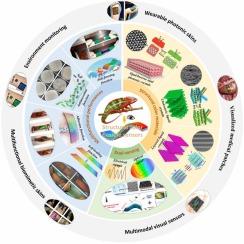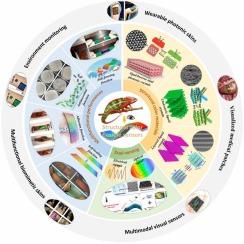Bio-inspired multifunctional flexible visual sensors based on structural color materials
IF 13.2
1区 工程技术
Q1 ENGINEERING, CHEMICAL
引用次数: 0
Abstract
With the development of smart materials, flexible sensors are becoming increasingly critical in many fields such as physiological monitoring and medical diagnostics. Conventional flexible sensors predominantly depend on cumbersome electronic equipment to exhibit and document signals, yet they fail to provide an intuitive visualization of data, which severely impedes their utility and advancement in cutting-edge domains, including human–computer interaction, intelligent interface design, and visual sensing. In recent years, inspired by the chameleon skin, researchers have been committed to the study of flexible sensors with visual interaction capabilities, which can directly visualize the response to the stimulus location through the color change observable with the naked eye. Herein, this review summarizes the prevalent methods for fabricating visually responsive materials with structural color, meanwhile exploring how these materials can be functionally incorporated into flexible sensors to facilitate the monitoring of human movement, physiological health and external environment. Notably, this paper deliberates on the latest research advancements of optoelectronic dual-signal response and multifunctionalized flexible vision sensors, and emphasizes the challenges and great potential for future advances in flexible vision sensing technology, pointing the way to the development of advanced multifunctional sensors.


基于结构色彩材料的仿生多功能柔性视觉传感器
随着智能材料的发展,柔性传感器在生理监测、医学诊断等领域发挥着越来越重要的作用。传统的柔性传感器主要依赖于笨重的电子设备来显示和记录信号,但它们无法提供直观的数据可视化,这严重阻碍了它们在人机交互、智能界面设计和视觉传感等前沿领域的应用和进步。近年来,受变色龙皮肤的启发,研究人员致力于研究具有视觉交互能力的柔性传感器,通过肉眼可观察到的颜色变化,直接可视化对刺激位置的反应。本文综述了目前常用的结构色视觉响应材料的制备方法,并探讨了这些材料如何在功能上与柔性传感器结合,以促进对人体运动、生理健康和外部环境的监测。重点介绍了光电双信号响应和多功能柔性视觉传感器的最新研究进展,强调了柔性视觉传感技术未来发展的挑战和巨大潜力,为先进多功能传感器的发展指明了方向。
本文章由计算机程序翻译,如有差异,请以英文原文为准。
求助全文
约1分钟内获得全文
求助全文
来源期刊

Chemical Engineering Journal
工程技术-工程:化工
CiteScore
21.70
自引率
9.30%
发文量
6781
审稿时长
2.4 months
期刊介绍:
The Chemical Engineering Journal is an international research journal that invites contributions of original and novel fundamental research. It aims to provide an international platform for presenting original fundamental research, interpretative reviews, and discussions on new developments in chemical engineering. The journal welcomes papers that describe novel theory and its practical application, as well as those that demonstrate the transfer of techniques from other disciplines. It also welcomes reports on carefully conducted experimental work that is soundly interpreted. The main focus of the journal is on original and rigorous research results that have broad significance. The Catalysis section within the Chemical Engineering Journal focuses specifically on Experimental and Theoretical studies in the fields of heterogeneous catalysis, molecular catalysis, and biocatalysis. These studies have industrial impact on various sectors such as chemicals, energy, materials, foods, healthcare, and environmental protection.
 求助内容:
求助内容: 应助结果提醒方式:
应助结果提醒方式:


